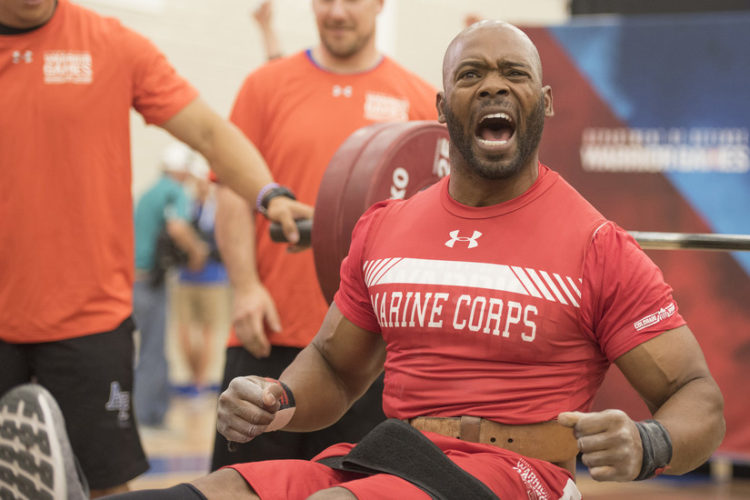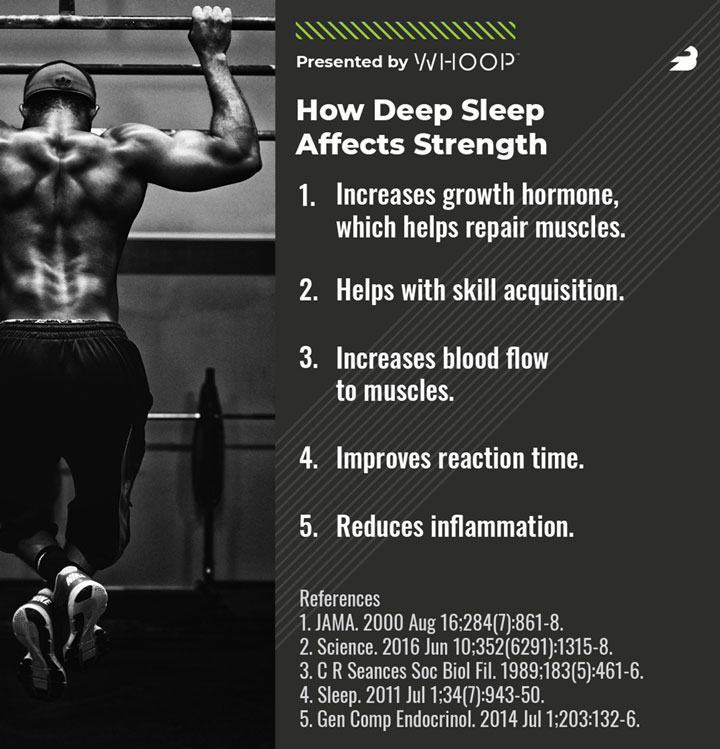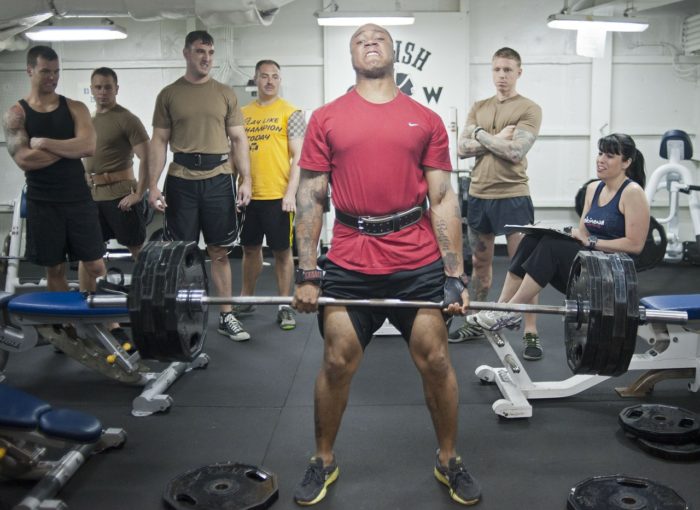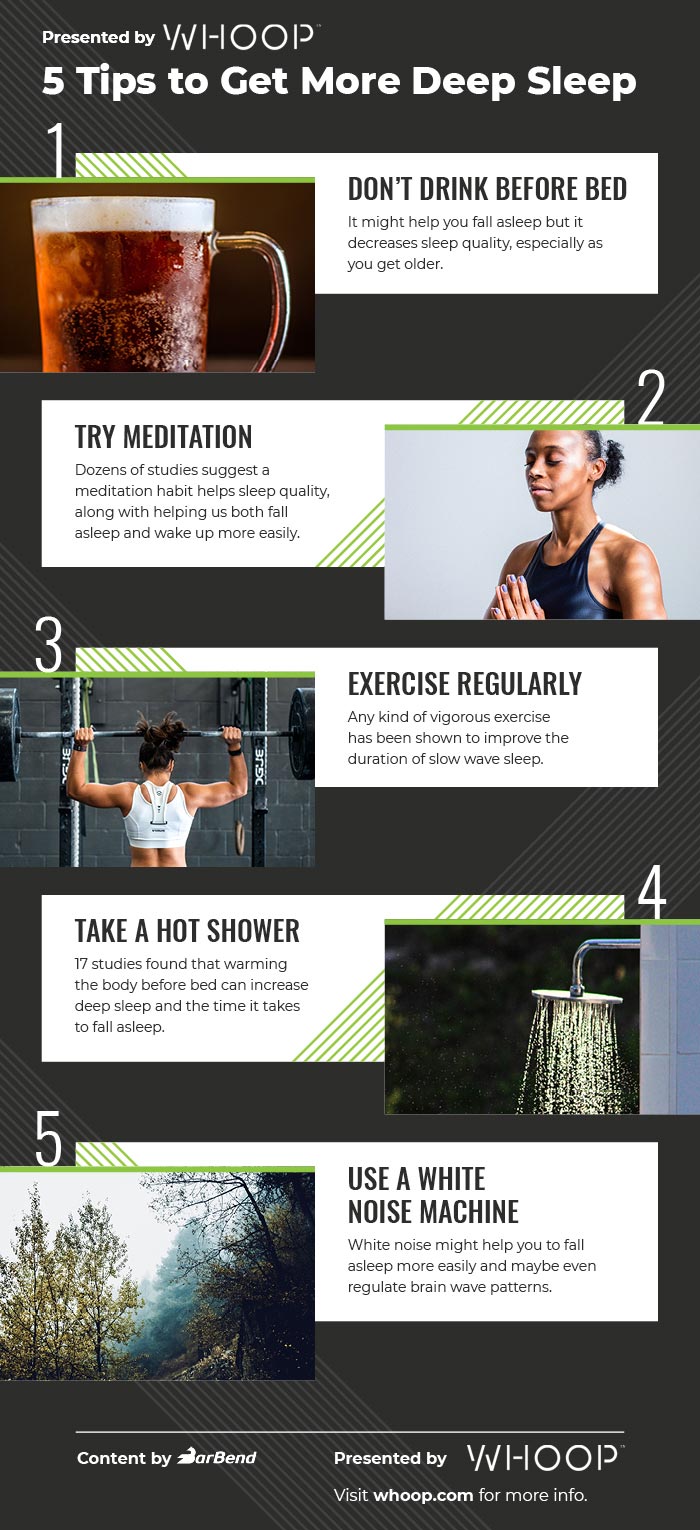Getting “deep sleep” doesn’t just mean “a good night’s sleep” or “I didn’t toss and turn all night.” It’s a specific, scientific term and if you have any interest in improving you strength and your performance in the gym, it’s important to pay attention to its meaning
Most people will close their eyes at night and get out of bed in the morning, but they may not achieve the ideal amount of deep sleep for them to feel rested and to enjoy its vast benefits, many of which should be particularly compelling for strength athletes. We’re talking about increased growth hormone for muscle repair and fat loss, lower levels of inflammation and associated joint pain, improved skill acquisition, and more.
Ideally, we want to spend roughly a quarter of the night in a state of deep, or “slow wave” sleep. come from spending roughly a quarter of their night in a state of deep, or “slow wave” sleep. The average person used to have no idea if they were reaching that goal, but with the rise of trackers like WHOOP, it’s easier than ever to pinpoint where you need help in your sleep cycle so you can optimize your strength.


Optimize your performance and recovery with the WHOOP fitness tracker. Tracks and quantifies recovery, sleep, activity, heart rate, HRV, and more.
What Are the Stages of Sleep?
The stages of sleep look like this:
N1: This is right after you fall asleep and it’s a kind of transition stage as you make your way to deeper sleep. Lasts about one to seven minutes.(1)
N2: The heart rate and body temperature decrease and brain waves slow, although brief bursts of brain activity called sleep spindles may occur. It’s thought that sleep spindles help consolidate the day’s memories.(2) N2 should last from 10 to 40-ish minutes after falling asleep.
N3: Also called slow wave sleep, this is the deepest and most restorative of the sleep stages — even REM. It’s very hard to wake from, and several important physiological changes occur, which we’ll detail in the next section. Roughly speaking, it lasts from 40 to 80 minutes of the (again, roughly) 100-minute sleep cycle.
REM: This occurs at the end of the sleep cycle, before you switch back to light sleep and start the process all over again. Although it’s when the most vivid dreams take place, it’s the lightest stage of sleep except for N1: the brain is active and energized and the heart and breathing rates aren’t as slow as they are in deep sleep.
While it’s lighter and less restorative than deep sleep, REM sleep still appears to be important for immunity, hormone production, and neurological health.(3)
What Is Deep Sleep?
Also called NREM 3, slow wave sleep, or delta sleep, a lot of blood flow in the brain is reduced (which is why mental performance can be impaired for up to half an hour when awoken from this stage(4)) and a variety of processes take place that affect both overall health and sports performance:
- Hormones related to appetite control, like ghrelin, are modulated. Research suggests that ghrelin stimulates the appetite, and not getting enough quality sleep could lead to an excess of the stuff. Even if you’re trying to gain muscle and get in a calorie surplus, that’s bad. It appears that a lot of ghrelin and insufficient sleep is more likely to produce “hedonic” cravings — that’s processed, not-so-muscle-friendly foods like pizza and pasta.
- Memory consolidation continues. Those aforementioned sleep spindles continue in deep sleep, and this is an underrated reason why deep sleep is important for skill acquisition for athletes.(5)(6) A study from Stanford University, for example, found ten hours of quality sleep per night to increase reaction time and accuracy for every one of the basketball players studied.(7)
- Blood flow to muscles increases, so they can receive nutrients and oxygen.
- Most of our prolactin, a hormone that boosts immunity and manages inflammation, is released.(8)(9)(10) More inflammation means the immune system is overstimulated and it’s linked to a massive variety of illnesses along with joint pain, arthritis, decreased sports performance — and insomnia.
- Production of cortisol, commonly called “the stress hormone,” is suppressed. While some cortisol can be useful for eliciting performance in a sport, it’s a little like adrenaline in that too much of it at the wrong times can lead to inflammation and sleeping troubles, among other issues.
- 75 percent of the body’s production of growth hormone takes place, increases, helping to repair muscles and reduce body fat.(11)(12)
[Learn how the WHOOP Strap is helping athletes achieve deeper, more restorative sleep]
Deep Sleep’s Impact on Strength Performance
Every last one of the benefits above can benefit athletes: dieting gets easier, skill acquisition and coordination improves, inflammation and stress decreases.
For those who want more concrete data on deep sleep that directly ties it to, say, a bigger bench press, you’ve got it. A popular study in Ergonomics compared male subjects’ performance on in the bench, leg press, deadlift, and bicep curl from when they were well rested to when they had three hours of sleep for three nights.(13) That’s a big drop in deep sleep, and the athletes had a significant decrease in strength (up to 20 percent) in the big three. (Interestingly, they didn’t in the bicep curl — an isolation exercise that doesn’t require as many muscle contractions.)
An analysis published in the French journal Comptes rendus des séances de la Société de biologie et de ses filiales found that when they woke up endurance athletes in the middle of the night, their VO2 Max decreased on the bike ergometer, suggesting their aerobic pathways were impeded by acute sleep loss.(14) That has ramifications not only for endurance athletes but strength athletes as well.
How Do I Know if I’m Getting Enough Deep Sleep?
Short of sleeping in a laboratory with electrodes hooked up to your noggin, it used to be very difficult to be certain of how much deep sleep you were getting. But activity trackers like WHOOP have made it easier than ever. The WHOOP Strap 3.0 is able to use metrics like your heart rate variability — the amount of time that passes between heartbeats — to ascertain how much time you spend in each stage of sleep. You want about 20 to 25 percent of your sleep to be deep.
Not getting enough?
How to Get More Deep Sleep
Anything you can do to improve sleep quality can help, here. Consider these tips:
- Don’t drink before bed. While it might help you get to sleep, alcohol is notorious for messing with sleep quality, especially as we age. It appears to cause an increase in N1 — the light sleep — and a decrease in deep and REM sleep, particularly in the second half of the night.(15)(16)
- Work to minimize snoring. This research is early, but some rodent research has suggested that the more oxygen we get while we sleep, the more deep sleep we get.(17) Snoring and sleep apnea reduce the amount of oxygen in the blood because the body isn’t breathing as deeply and smoothly as it should be. Remedying snoring is a big topic but maintaining a healthy weight, sleeping on one’s side, avoiding alcohol, raising the head of the bed (or getting a thicker pillow), and nasal strips or a nasal dilator may help. It’s worth seeing a specialist if you’re concerned.
- Consider a meditation habit. Research suggests that meditating before bed improves sleep quality.(18)(19) That doesn’t mean it’s a cure-all, but a simple habit of spending 5 to 10 minutes of counting your breaths while doing your best to think of nothing else — harder than it sounds — can be very effective at inducing sleep and improving sleep quality.
- Get a workout habit. Vigorous exercise has been shown, time and time again, to improve the duration of slow wave sleep.(20) Any kind of exercise counts, but try to break a sweat and get out of breath.
- Take a hot shower or bath. An analysis of 17 studies suggests that warming the body before bed can improve total sleep time, slow wave sleep, subjective sleep quality, sleep efficiency and the time it takes to fall asleep.(21) It found that while hot showers or baths (104 to 109 degrees) help with sleep and colder showers wake us right up.
- Try a white noise machine. There’s good evidence that white noise can help people to fall asleep and even regulate brain wave patterns.(22) This is especially useful if you live in a not-quite-quiet area.
Wrapping Up
Sleeping and sleeping well are two different things, and it’s important to know that your sleep quality is as good as it can be if you want to perform at your best inside the gym and outside of it as well. To measure how well you sleep, pick up a tracker like the WHOOP Strap 3.0. To make things better, consider these tips — and maybe lay off the afternoon coffee.
References
- Waterhouse J, et al. Daily rhythms of the sleep-wake cycle. J Physiol Anthropol. 2012 Mar 13;31:5.
- Nielsen T, et al. NREM Sleep Spindles are Associated with Dream Recall, Sleep Spindles & Cortical Up States: A Multidisciplinary Journal, 2016
- Pase MP, et al. Sleep architecture and the risk of incident dementia in the community. Neurology. 2017 Sep 19;89(12):1244-1250.
- Aakash K. Patel, John F. Araujo, Physiology, Sleep Stages, StatPearls Publishing, Oct. 27, 2018
- Miyamoto, D. Top-down Cortical Input During NREM Sleep Consolidates Perceptual Memory. Science, June 10, 2016
- Payne JD, et al. Sleep, dreams, and memory consolidation: the role of the stress hormone cortisol. Learn Mem. 2004 Nov-Dec;11(6):671-8.
- Mah CD, et al. The effects of sleep extension on the athletic performance of collegiate basketball players. Sleep. 2011 Jul 1;34(7):943-50.
- Besedovsky L, et al. Sleep and immune function. Pflugers Arch. 2012 Jan;463(1):121-37.
- Adán N, et al. Arthritis and prolactin: a phylogenetic viewpoint. Gen Comp Endocrinol. 2014 Jul 1;203:132-6.
- Eugene AR, et al. The Neuroprotective Aspects of Sleep.MEDtube Sci. 2015 Mar;3(1):35-40.
- Vgontzas AN, et al. Sleep deprivation effects on the activity of the hypothalamic-pituitary-adrenal and growth axes: potential clinical implications. Clin Endocrinol (Oxf). 1999 Aug;51(2):205-15.
- Van Cauter E, et al. Age-related changes in slow wave sleep and REM sleep and relationship with growth hormone and cortisol levels in healthy men. JAMA. 2000 Aug 16;284(7):861-8.
- Reilly T, et al. The effect of partial sleep deprivation on weight-lifting performance. Ergonomics. 1994 Jan;37(1):107-15.
- Mougin F, et al. [Disturbance of sports performance after partial sleep deprivation]. C R Seances Soc Biol Fil. 1989;183(5):461-6.
- Colrain IM, et al. Alcohol and the sleeping brain. Handb Clin Neurol. 2014;125:415-31.
- Park SY, et al. The Effects of Alcohol on Quality of Sleep. Korean J Fam Med. 2015 Nov;36(6):294-9.
- Hauer BE, et al. Hyperoxia enhances slow-wave forebrain states in urethane-anesthetized and naturally sleeping rats. J Neurophysiol. 2018 Oct 1;120(4):1505-1515.
- Rusch HL, et al. The effect of mindfulness meditation on sleep quality: a systematic review and meta-analysis of randomized controlled trials. Ann N Y Acad Sci. 2019 Jun;1445(1):5-16.
- Gong H, et al. Mindfulness meditation for insomnia: A meta-analysis of randomized controlled trials. J Psychosom Res. 2016 Oct;89:1-6.
- O’Connor PJ, et al. Influence of exercise on human sleep. Exerc Sport Sci Rev. 1995;23:105-34.
- Haghayegh S, et al. Before-bedtime passive body heating by warm shower or bath to improve sleep: A systematic review and meta-analysis. Sleep Med Rev. 2019 Aug;46:124-135.
- Ngo HV, et al. Auditory closed-loop stimulation of the sleep slow oscillation enhances memory. Neuron. 2013 May 8;78(3):545-53.



